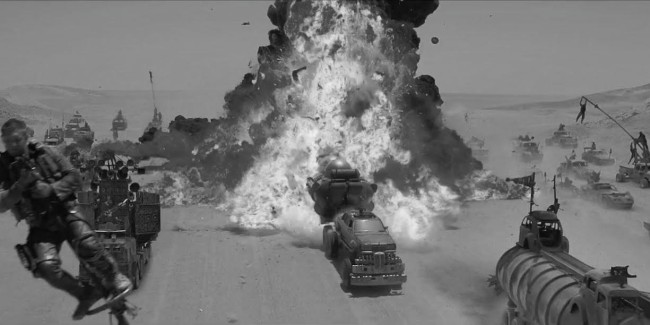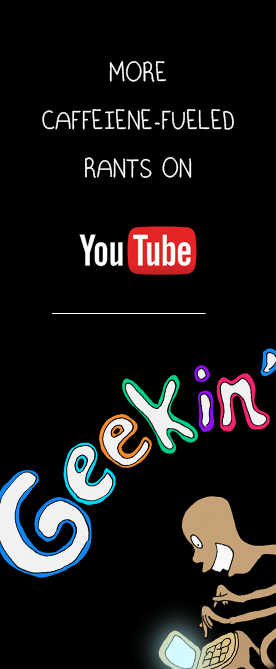Mad Max maestro George Miller has decided that his latest entry into the Ozploitation series, Fury Road, isn’t pared down enough. The movie runs as lean as it can for a two-hour actioner. A “tone poem” of mayhem and violence—as some have dubbed—a dubbing I enthusiastically endorse. The story is like a tautly flexed arm, so skinny and solid that all its veins and tendon and muscle are on full display, its entire narrative is there for us to see, and without Miller having to point it out to us with the obnoxious flare of a talentless braggadocio. Still, Miller thinks the film could use even more stripping. He wants the blu-ray copy of Fury Road to feature a Black & White option.
Here’s what the man’s got to say:
“The best version of this movie is black and white, but people reserve that for art movies now. The other thing you can do is go really all-out on the color. Teal and orange are the colors we had to work with. The desert is orange and the sky is teal, and you can either de-saturate it to crank it up. It can get really tiring watching dull, de-saturated color, unless you go all the way out and make it black and white.”
I understand Miller’s concern with whether or not people will find artistic validity in his movie(s). But I think it’s there. I think Fury Road is a masterwork that has had the great pleasure of depreciating the value of any action movie unfortunate enough to be released in close proximity (which, by my definition, is a decade or so). And not only action movies, but haughty-taughty, super serious art house fare, too. The artistry resides in how Miller executed his intent, which he did, with precision. Sliced off every slab of fat he could find.
That being said, not sure if I need Fury Road in Black & White. I understand Miller wants to stand out. He’s a director with genre ideas, but with an artist’s hand and eye that sculpts and composes; he polishes and sands and bevels the edges till you can no longer see the effort involved, but people—as they do—will ignore the art and witness the blood, the speed, the scantly clad women, the post-apocalyptic terrain, the monstrously-enhanced muscle cars, and forget the thought, the calculation, and sweat and creativity that went into the film’s conception.
I think one of the things that is keeping Fury Road from being shrugged off as yet another piece of spectacular mediocrity—amongst many, many, MANY other things—is the color and the super saturated vividity of its set pieces. Have you seen a post-apocalyptic world so vibrantly painted before? Miller’s right to say that movies are way under lit these days, and it’s to the point where I’m not sure if it’s intentional or not. The biggest offender of this new movement of lighting—the greatest propagator—is Netflix and its two data-aggregated “thrillers” House of Cards and Bloodline. They don’t paint with light as much as they splatter. There’s little thought behind the exposure of people’s faces, what shadows may or may not mean. Instead, they darken the whole scene and say it’s because the characters are shady. It’s false gravitas, false tension. More than anything else, it’s fucking annoying.
I can’t remember the last time a movie’s been so flamboyantly saturated without hauling around the Wes Anderson cross of coloring approval. Lesser filmmakers think that achieving gravitas means shrouding characters in super expressionistic lighting, with greenish, brownish—and sometimes bluish—tints, but all it does—simply and solely—is leaden a movie. Movies like that sink like stones in water, where as Fury Road, despite its grim reality, remains buoyant and bouncy upon the tempestuous waters of Miller’s ocean of creativity and despair. To color this film in Black & White would grate against Miller’s initial purpose: to show all his PG-13 competitors the opportunities they’ve been squandering in attempt to force their ideas and stories into “adulthood,” with severe story lines, scowling protagonists, icy cold, slicked-up, clinical camerawork—or, on the flip side, shaky frames that’re supposed to capture the “intensity” of “reality”.
Fury Road is a movie that knows it’s a movie, but without the self-awareness of the fourth wall—or rather, the acknowledgement of the fourth wall. It only knows that it isn’t real, and when people are confronted by an event that’s real or extraordinary, they tend to stop and watch and soak in the sights. Miller lets us look and absorb, he gives us enough time with each frame that we know what’s up, and we know to go slack-jawed and gape stupidly at the grandeur that he’s taken many hours, many days, several months, maybe a year or two, to invent for us. Miller knows the effort he’s put in, and now he wants to brag—just a little—and show us the splendor and how his movie WAS PERFECT IN EVERY WAY!
By blighting the movie’s palette with Black & White, Fury Road WILL become every other art house flick. I understand how brave a decision it must be to fight for a Black & White print of a several-hundred-million-dollar movie, but it strikes me as a vapid and affected crack at credibility when the film’s already juicing with it. More so than anything else, by draining the color out of Fury Road—which, mind you, was the very first thing I noticed about the film’s initial trailer—it will prove to be nothing more than an empty hunt for something like “prestige”. This movie is big, its wild, and its unhinged, there’s nothing keeping it from hurtling forward at full force, limbs akimbo, and with a sense of cinematic decency that’s broken up like a zig-zagged spine. It’s got integrity, it’s got bravado. To change the print—and this late in the game—would show weakness, it would show a willingness to perform for accolades rather than rarity.
Also, before I sign off, the real atrocity isn’t the B&W v. Color debate, the real problem is the gratuitous display of what was—I’m assuming—supposed to be a full-on 3D shot at the end of the film when War Boy Nux (Nicholas Homastult) sacrifices himself to a multi-car explosion that then flings a steering wheel and flame-throwing guitar at—and “through”—the fourth wall. As far as I can remember, that was the only shot catered to the film’s slapshod 3D experience, which causes me to speculate the timing of the studio’s decision to roll outFury Road with a 3D option. I keep failing to mention this in all my reviews and rants and analyses of the movie, but this moment violently rips me out of the movie and its world. This is, unfortunately, one of those instances where I can see Miller’s hand at work, his sweat, his furrowed brow, his roiled and bruised labor. Here’s a moment where you see the battered artist too exhausted to veil his hurt.






